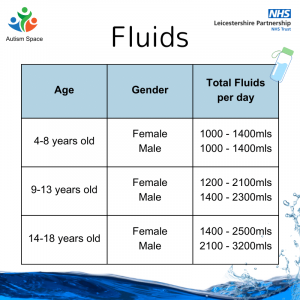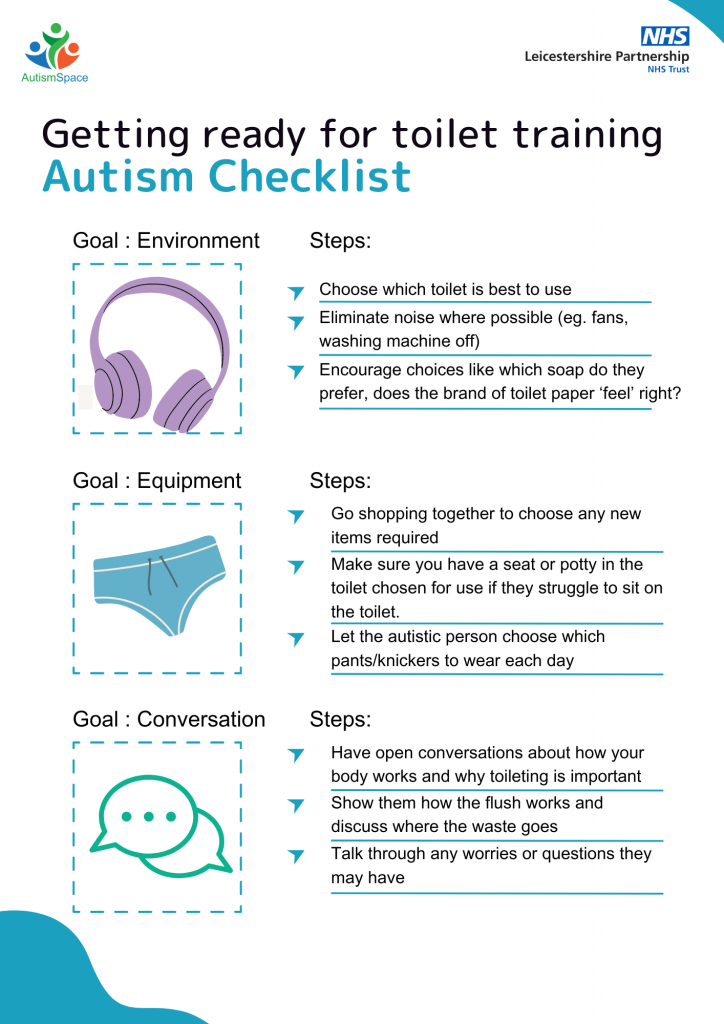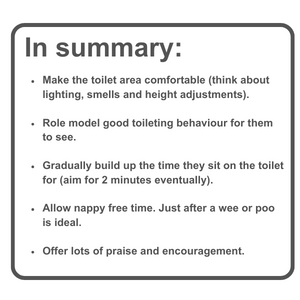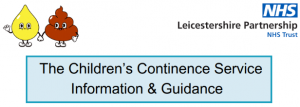Factors that can contribute to this include:
- Being overly sensitive and / or lacking sensitivity to sensory information
- Communication differences
- Difficulties adapting to changes in routines and in tolerating the unexpected
- Learning disabilities
- Distractibility
- Digestive issues
The longer a child wears nappies or any product, the more difficult it can be for them to learn healthy toilet habits. Autistic children might not feel as motivated to wear pants or use a toilet like most neurotypical children. They may also struggle to recognise when they need to go to the toilet, or if they are wet or dirty
This can result in parents/carers postponing the preparation work to build the skills needed for toilet training until the child appears ready – with some children never appearing to be ready.
Preparing an autistic child for toilet training
Constipation
Firstly, make sure that you recognise the signs and understand symptoms of constipation. Click here for more information on constipation. Autistic children can be prone to constipation. This can be due to a rigid diet, low fluid intake and /or avoidance in passing stools (poo). Constipation can have a negative impact on toilet training. It can sometimes take a long-time to resolve. If your child is constipated, take them to a GP.
Drinks
To avoid or reduce constipation, offer plenty of water-based drinks on top of any milk. Spread this out over the day aiming for 6- 8 ,200ml sized drinks. If your child struggles to drink the recommended amounts, try offering jelly, ice lollies, smoothies, and other water-based fruits (melon, oranges, and pineapple). Also, avoid caffeine and carbonated drinks – as these can cause bladder overactivity.
Click here to view or download an accessible pdf of this graphic
Sensory Environment
Find ways to make going to the toilet an intrinsically rewarding experience, making the environment comfy and pleasurable for your individual child.
- Make it easier for your child to physically access the toilet. For example, add foot supports, side rails and a smaller toilet seat, if necessary
- Make sure your child can sit comfortably on the toilet/potty with knees bent and feet flat on a stool.
- Encourage independence by ensuring that everything in the bathroom is at the right level for your child, for example soap and towels, with access to a step if this is not possible.
- Remove any distractions, if necessary.
- Think about your child’s sensory needs and make changes to reduce their anxiety. Do they dislike the scent of the soap? Does the noise of the fan bother them? Does the water temperature need to be adjusted? Is the lighting too bright?
Click here to view or download an accessible pdf of this graphic
Toilet Training with An Autistic Child
Always remove, change, and replace continence products/nappies in a toilet area. This enables them to associate wees and poos with the appropriate environment. If you know when your child is likely to do a wee or poo, by their body language, encourage them to do this in the toilet area – whether in a nappy, potty or toilet.
Parents/carers can apply for a ‘Radar’ key from their local authority or Bladder and Bowel UK. This allows access to public disabled toilets when out and about. If you are going to an unfamiliar place, then you could use the app called ‘Flush Toilet Finder’: This app is available on both Android and iOS and helps you find public toilets.
Let your child watch other family members using the toilet where appropriate! Role model normal behaviour – including sitting or standing to go to the toilet, flushing and handwashing. This will help the child know what is expected of them and may also reduce anxiety.
Encourage your child to sit on the potty/toilet as soon as they are physically able. Try gradually building up to sitting on the toilet for 2 minutes (long enough to do a wee/poo). Sitting on the toilet 20 minutes after breakfast and / or the evening meal and building a changing and toilet time routine into the day can be a successful strategy. Give praise for any attempts – even if they don’t produce wee or poo and / or they only sit for a short time. Consider using a song or timer to aid with this.
If your child is anxious about using the toilet, they may need a gradual approach to help them learn to use the toilet independently. For example, at first your child could sit on the toilet with the nappy/product still on. You can try a training seat/insert seat to help them feel more secure. If your child is too big for a potty but does not feel secure on a toilet, a camping toilet in the bathroom could be a good transition. If your child feels physically uncomfortable with the nappy removed, you could try cutting a hole in the nappy and sitting them on the toilet. Alternatively, you can try to gradually loosen the nappy off.
For children who are nervous about the noise or the splash, you can put toilet paper in the toilet first to reduce this. Boys who wish to stand up at the toilet may find it helpful to aim at something – such as a ping pong ball in the toilet bowl.
Allowing your child to have nappy/product free time, prepares them to know what it feels like to not wear nappies or products. A good time to do this, would be after they have done a wee or poo, to limit the number of accidents. Disposable nappies or pull-ups are effective at locking away moisture. If your child has sensory sensitivities, they may struggle to feel when they have done a wee. To help them recognise the wet sensation when they wee, try putting pants on under the nappy/product.
Involve the child in the whole process. For example, encourage them to fetch or hold equipment, remove their continence products/nappies and wipe themselves clean. When able, change the nappy/ continence product when your child is standing up. This enables them to take a more active part. Choose clothing your child can manage more easily by themselves. You might need to avoid tights, belts and buttons. If your child struggles to wipe themselves, try toilet wipes or do it together with your hand over theirs.
Be consistent with what you do, how and when you do it. If you need to make any changes, explain these beforehand, so that it is not such a surprise. Use consistent language throughout, including for any praise, for example:
‘Let’s go to the toilet’ or ‘Well done, you’ve done a poo!’
Using words like ‘wet and dry’ and / or ‘clean and dirty’ can help your child learn to feel the difference – and recognise that their body feels comfier after they have been to the toilet. If you choose to use family language instead of common terms, this needs to be consistent in all settings. Therefore, you may need to advise any other adults taking care of your child, such as nursery/school staff.
To embed routine and help your child to learn and remember new words – you can use signs and symbols. Click this link for more information on communication support.
Autistic people may prefer things to be factual and realistic, it may be helpful for your child to understand the processes of what is happening in their digestive system – Explain how the body changes food and drink into poo and wee.
Empty poo from a nappy or potty down the toilet – both you and your child can do this together to show your child where poo needs to go after it has come out of the body. Encourage your child to flush – or if this is not possible, demonstrate for them. Explain where the poo/wee is going -through the pipes, under the roads, all the way to the sewerage plant to be cleaned up and back through the sewerage system.
It can be helpful to give your child advance warning and / or use a countdown – for example ‘Ready, steady Flush!’ This can help them know what to expect, prepare for the noise and splashing – and so reduce anxiety. Some children might find it helpful to say ‘goodbye’ to the poo. Again, bear in mind some autistic children might find it confusing or upsetting to say goodbye to an inanimate object. This is because some autistic children find it hard to differentiate between what is a living being and what is not.
You may hear lots of advice and tips from other parents around encouraging using the toilet. It is important to remember that whatever strategies you use needs to work for your autistic child and you even when you are not at home.
Click here for a children’s story and colouring book ‘Poo goes to pooland’
Encourage your child to wash their hands after changing their nappy/continence product or using the potty/toilet. Demonstrate and name the same steps each time: eg
‘sleeves up’,‘tap on’,‘wet hands’,‘squirt soap’,‘rub hands together’
‘ rinse hands’,‘turn off tap’.‘shake hands’and ‘dry hands’
As the routine becomes more consistent you could consider using a timer or singing a song to encourage your child to wash their hands for a longer period of time.
Use an approach with toileting that gradually decreases the level of support as necessary over time.
- Demonstrate what to do – explain what you are doing, say the corresponding phrase at each stage – eg ‘nappy off’
- Display a visual that has photos or symbols to represent the step-by-step stages if your child needs prompts.
- Be close to your child, use hand over hand physical prompts, say the phrases, refer to the visual – pointing at the corresponding picture as appropriate.
- Be with your child, but further away – withdraw the physical prompts and simply say the phrases and refer to the visual as necessary.
- Stand away from your child, see what they can remember to do without prompting – give them clues and or / remind them to use the visual as a prompt, if they forget – eg: ‘What’s next?.. It begins with a /t/ sound?. It’s this picture – that’s right, it’s turn off taps!’
In time your child should be able to use the visual prompt and do all the steps independently – and in time, the visual prompt will no longer be needed.
Further Support with toilet training an autistic child.
If you try the ideas above but are struggling with toilet training your child, you can refer to your Healthy Together Health Visitor/School Nurse on: –
Chat Health Text Parents City 07520 615 382
Chat Health Text Parents County 07520 615 382
If your child is at nursery or school, you could ask staff to refer on your behalf.
The Healthy Together Health Visitor/School Nurse team could support you further with
– Toilet training strategies over time
– Completing the Healthy Bladder, Healthy Bowel Parent Carer Information Session for Children with Additional Needs:
Click here to see a leaflet from the Children’s Continence Service
If your child is still struggling with learning to use the toilet and is still wearing nappies/continence products, you may be offered a holistic continence assessment. To access this, parents/carers would need to complete the Healthy Bladder, Healthy Bowel Parent Carer Information Session for Children with Additional Needs. They would need to complete charts to record drinking, bladder, and bowel function
If your child is having struggles with sensory processing issues related to toilet training, you could ask a health care professional (including GPs) or school/nursery to make a referral for an Occupational Therapy Parent Education Workshop. Click this link to find a form for the health care professional to complete for this.
The provision of continence products/nappies for daytime wetting is based on a clinical need – and would only be considered following engagement with the Healthy Together Health Visiting teams/ School Nurse Team
The ongoing cost of nappies/products is expensive, and the entitlement of prescribed nappies is not based on age or diagnosis – and no products are prescribed for any children under the age 5. However, even if nappies are prescribed, pull-ups are not routinely prescribed unless in exceptional circumstances.
You may also find these organisations helpful:
Bladder and Bowel UK Helpline on 0161 214 4591
Potty Training Guide for parents of autistic kids
_____________________________________________________________________________________________________________________________________________________________
For our directory of health related resources and services, please click here
_____________________________________________________________________________________________________________________________________________________________





